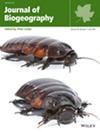Rampant Dispersal Without Gene-Flow: Reproductively and Geographically Isolated Lineages of the Supertramp Lizard Lamprolepis smaragdina Permeate the Lesser Sunda Archipelago
Abstract
Aim
We investigated the biogeographical patterns of a widespread arboreal lizard found throughout Wallacea and the western Pacific islands. Wallacea contains longstanding oceanic currents that flow from the Pacific Ocean into the Indian Ocean, known as the Indonesian Throughflow. Using genetic data, we aim to estimate the timing and sequence of island colonisation in the Lesser Sunda archipelago of southern Wallacea, and to determine the proportion of dispersal events that may have been aided by ocean currents. Levels of gene flow are also explored in the context of island arrangement, past connectivity (ex. Pleistocene land bridges), and ocean currents.
Location
Southern Wallacea (Indonesia, Timor-Leste).
Taxon
Emerald Tree Skink (Lamprolepis smaragdina).
Methods
We estimated a mitochondrial DNA phylogeny from southern Wallacean populations to identify divergent populations and to guide sample selection for genomic-scale data collection. These genomic data were used to estimate (1) phylogenetic relationships of island populations using both concatenated Maximum Likelihood, summary coalescent and multispecies coalescent methods, (2) levels of genetic connectivity between lineages using genetic clustering and migration analyses, and (3) to reconstruct their dispersal history using ancestral range reconstruction analysis.
Results
We found that the Emerald Tree Skinks of southern Wallacea diverged from a population on Peleng Island ~1.25 Ma and that Lesser Sunda populations diverged between ~1 and 0.4 Ma. MtDNA data are insufficient to estimate the relationships of each population and find one island to be paraphyletic and two to be polyphyletic. Genomic data find that Timor Island is polyphyletic while all other islands are recovered as monophyletic. Gene flow is minimal or absent across the archipelago, even between islands that become periodically land bridged. More than half of the estimated over-water dispersal events occurred perpendicular to or against ocean currents.
Main Conclusions
Despite this species' over-water dispersal abilities island populations are genetically isolated from one another, even on adjacent islands that become periodically land bridged. This suggests that species formation is complete. The inferred dispersal history involved many paths that would be difficult to complete given the direction of ocean currents, indicating that historical ocean currents are more dynamic than currently understood.


 求助内容:
求助内容: 应助结果提醒方式:
应助结果提醒方式:


